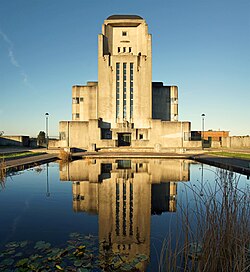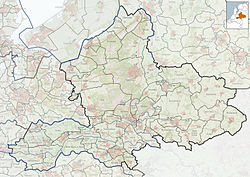
Shortwave radio is radio transmission using shortwave (SW) radio frequencies. There is no official definition of the band, but the range always includes all of the high frequency band (HF), which extends from 3 to 30 MHz ; above the medium frequency band (MF), to the bottom of the VHF band.
International broadcasting, in a limited extent, began during World War I, when German and British stations broadcast press communiqués using Morse code. With the severing of Germany's undersea cables, the wireless telegraph station in Nauen was the country's sole means of long-distance communication.

AM broadcasting is radio broadcasting using amplitude modulation (AM) transmissions. It was the first method developed for making audio radio transmissions, and is still used worldwide, primarily for medium wave transmissions, but also on the longwave and shortwave radio bands.

A radio clock or radio-controlled clock (RCC), and often (incorrectly) referred to as an atomic clock is a type of quartz clock or watch that is automatically synchronized to a time code transmitted by a radio transmitter connected to a time standard such as an atomic clock. Such a clock may be synchronized to the time sent by a single transmitter, such as many national or regional time transmitters, or may use the multiple transmitters used by satellite navigation systems such as Global Positioning System. Such systems may be used to automatically set clocks or for any purpose where accurate time is needed. RC clocks may include any feature available for a clock, such as alarm function, display of ambient temperature and humidity, broadcast radio reception, etc.

In radio, longwave, long wave or long-wave, and commonly abbreviated LW, refers to parts of the radio spectrum with wavelengths longer than what was originally called the medium-wave broadcasting band. The term is historic, dating from the early 20th century, when the radio spectrum was considered to consist of longwave (LW), medium-wave (MW), and short-wave (SW) radio bands. Most modern radio systems and devices use wavelengths which would then have been considered 'ultra-short'.
JJY is the call sign of a low frequency time signal radio station located in Japan.

Radio Netherlands was a public radio and television network based in Hilversum, producing and transmitting programmes for international audiences outside the Netherlands from 1947 to 2012.
RTÉ Radio 1 is an Irish national radio station owned and operated by RTÉ and is the direct descendant of Dublin radio station 2RN, which began broadcasting on a regular basis on 1 January 1926. The station is a rare modern example of a mixed radio channel, offering a wide spectrum of programming which is mainly speech-based but also includes a fair amount of music.
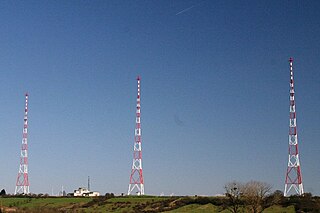
The Junglinster Longwave Transmitter is a longwave broadcasting facility used by RTL near Junglinster, Luxembourg, which went into service in 1932. Its aerial consists of three free-standing steel-framework towers, which are ground fed radiators. These towers formed a directional aerial for the frequency 234 kHz and until 1980 were 250 metres high. Since 1980 their height has been 215 metres.
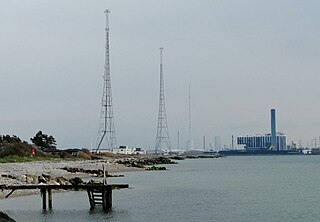
Kalundborg Radio is a major transmission facility for long- and mediumwave at the harbour of Kalundborg in Denmark.

Grimeton Radio Station in southern Sweden, close to Varberg in Halland, is an early longwave transatlantic wireless telegraphy station built in 1922–1924, that has been preserved as a historical site. From the 1920s through the 1940s it was used to transmit telegram traffic by Morse code to North America and other countries, and during World War II was Sweden's only telecommunication link with the rest of the world. It is the only remaining example of an early pre-electronic radio transmitter technology called an Alexanderson alternator. It was added to the UNESCO World Heritage List in 2004, with the statement: "Grimeton Radio Station, Varberg is an outstanding monument representing the process of development of communication technology in the period following the First World War." The radio station is also an anchor site for the European Route of Industrial Heritage. The transmitter is still in operational condition, and each year on a day called Alexanderson Day is started up and transmits brief Morse code test transmissions, which can be received all over Europe.

The Transmitter Solt is a radio transmission facility for 540 kHz MW near Solt, Hungary, serving as the primary transmitter site for Kossuth Rádió. With an output power of 2000 kW, it is the most powerful radio transmitter in Europe and is among the most powerful radio transmitters in the world. Its intended broadcast area covers the Hungarian-speaking territories of Central- and Eastern Europe, however successful reception of the Kossuth Rádió was reported from as far as Michigan, United States and Kuala Lumpur, Malaysia. It uses a 303.6-metre tall guyed mast. The transmitter site has been a preserved industrial monument since 2013.

Allouis is a commune in the Cher department of the Centre-Val de Loire region of France.

The BBC National Programme was a radio service which was on the air from 9 March 1930 – replacing the earlier BBC's experimental station 5XX – until 1 September 1939 when it was subsumed into the Home Service, two days before the outbreak of World War II.
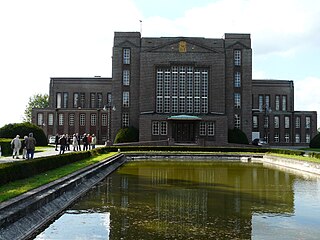
Nauen Transmitter Station in Nauen, Havelland district, Brandenburg, Germany, is the oldest continuously operating radio transmitting installation in the world. Germany's first high power radio transmitter, it was founded on 1 April 1906 by Telefunken corporation and operated as a longwave radiotelegraphy station through World War II, and during World War I became Germany's main link with the outside world when its submarine communications cables were cut. Upgraded with shortwave transmitters in the 1920s it was Germany's most advanced long range radio station, continually upgraded with the latest equipment and serving as an experimental station for Telefunken to test new technology. At the end of World War II, invading Russian troops dismantled and removed the transmitting equipment. During the Cold War it served as the GDR's international shortwave station Radio Berlin International (RBI), and was the East Bloc's second most powerful radio station, disseminating Communist propaganda to other countries. Since German Reunification in 1991 it has been operated by Deutsche Telekom, Germany's state telecommunication service. The original 1920 transmitter building designed by architect Herman Muthesius is still used; it is the only remaining building designed by that architect.

Assel is a hamlet in the municipality of Apeldoorn in the Netherlands, located close to the village of Hoog Soeren.

Laag-Soeren is a village in the Dutch province of Gelderland. It is about 4 km northwest of Dieren, in the municipalities of Rheden and Brummen. It used to be a spa town.

Hoog Soeren is a village in the municipality of Apeldoorn, in the province of Gelderland in the Netherlands. Since 1863, it is a crown land.
RBU is a time code radio station located in Moscow. It transmits a continuous 10 kW time code on 66⅔ kHz. This is commonly written as 66.66 or 66.666 kHz, but is actually 200/3 kHz. Until 2008, the transmitter site was near Kupavna 55°44′04″N38°9′0″E and used as antenna three T-antennas spun between three 150 metres tall grounded masts. In 2008, it has been transferred to the Taldom transmitter at 56°44′00″N37°39′48″E.

Wenum-Wiesel is a twin village in the municipality of Apeldoorn, in the province of Gelderland in the Netherlands. In 1978, the hamlets of Wenum and Wiesel merged into a village.
